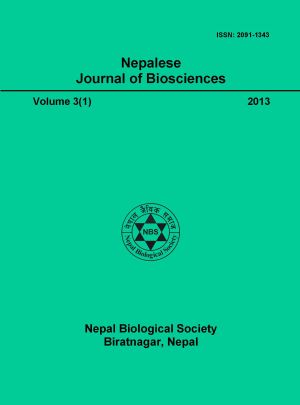Phytoplankton status of Mahakali River, Nepal
DOI:
https://doi.org/10.3126/njbs.v3i1.41422Keywords:
Diatoms, chlorophyceae, cyanophyceae, Microcystis, monsoonAbstract
Distribution of phytoplankton in Mahakali river was studied during 2003-2005. During the investigation a total of 31 genera belonging to 5 classes were identified. Chlorophyceae was dominant being represented by 15 genera, followed by Bacillariophyceae (9 genera), Cyanophyceae (5 genera), and 1 genus each of Dinophyceae and Xanthophyceae. The peak of Chlorophyceae was obtained in the month of April (465 units/l) during first year while in second year it was observed in the month of February (505 units/l). The maximum of Cyanophyceae was observed in the month of May (460 units/l) and March (216 units/l) during first and second year, respectively. Bacillariophyceae showed its maximum contribution during May (622 units/l) in first year and in March (600 units/l) in second year. The maximum density of phytoplankton was found during pre monsoon and minimum in early period of post monsoon (Sep.) and late period of monsoon. The density of phytoplankton increased from post monsoon (Oct.), whereas in rainy season, it was least due to dilution factor




